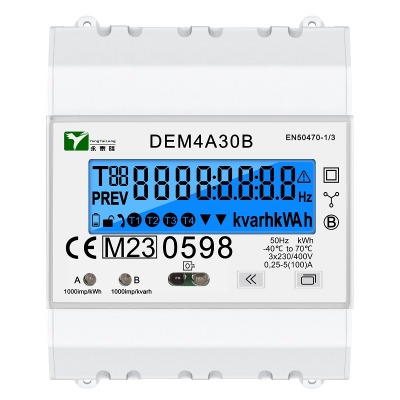Three Phase Power Meter and smart Three Phase Power Meter are two types of power meter which are commonly used to measure the electricity consumption of three phase power systems. With the rapid development of industry, electricity consumption has become increasingly important. Measuring and managing electricity consumption are crucial for optimizing energy efficiency.
The traditional Three Phase Power Meter measures the total energy consumption of a three phase power system. The system consists of three current transformers and three voltage transformers. These devices are used to measure the current and voltage of each phase separately. The power consumption can be calculated by multiplying the measured voltage and current. The total energy consumption is the sum of the power consumption of all three phases. This type of meter has the advantage of reliable performance and a simple structure, but it cannot provide detailed information about the power quality and load distribution of each phase.
In contrast, the smart Three Phase Power Meter is a highly precise instrument capable of measuring not just the overall power consumption, but also the power quality and load distribution for each individual phase. It has a built-in microprocessor that can record and analyze the waveform and frequency of the signal, as well as detect and correct power anomalies such as harmonic distortion and voltage fluctuations. The smart meter also has a two-way communication capability that allows for remote data transmission and real-time monitoring of energy consumption.
The smart Three Phase Power Meter has many advantages over the traditional Three Phase Power Meter. above all, it can help to optimize the power distribution and reduce energy waste by detecting the power quality and load distribution of different phases. For instance, if one phase consumes more power than the other phases, this could signify an imbalance in the load distribution. Consequently, the system can be adjusted to achieve a more even distribution of power. Secondly, a smart meter provides more accurate and detailed information about power usage, which is beneficial for billing and energy management. Thirdly, the remote data transmission and real-time monitoring capabilities can improve the efficiency and convenience of energy management, as well as reduce the cost and labor associated with manual meter reading and data collection.
However, there are also some challenges and concerns regarding the use of smart Three Phase Power Meter. One of the major concerns is the privacy and security of the data transmitted and collected by the smart power meter. As the meter have two-way communication capability, there is a risk of unauthorized access and manipulation of the data by third parties. Additionally, the installation and maintenance of the smart power meter may require specialized skills and equipment, which could pose a barrier to its widespread adoption.
In conclusion, the Three Phase Power Meter and smart Three Phase Power Meter are two important tools for measuring the electricity consumption of three phase power systems. While the traditional meter has been widely used due to its reliable performance and simple structure, the smart meter has many advantages over the traditional meter in terms of accuracy, functionality, and convenience. The smart meter can help to optimize energy efficiency and reduce waste, but also poses challenges and concerns regarding privacy and security. It is important to balance the benefits and risks of the smart meter in order to promote its adoption and maximize its potential for energy management.

 English
English 简体中文
简体中文




.png?imageView2/2/w/500/h/500/format/png/q/100)

.jpg?imageView2/2/w/500/h/500/format/png/q/100)

.png?imageView2/2/w/500/h/500/format/png/q/100)
.png?imageView2/2/w/500/h/500/format/png/q/100)

.png?imageView2/2/w/500/h/500/format/png/q/100)



